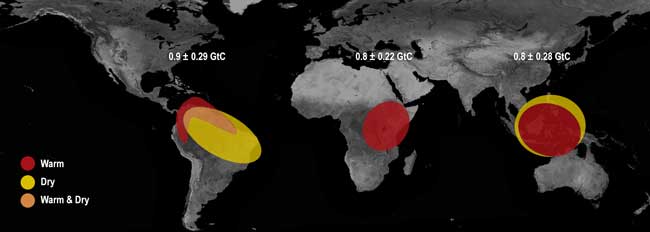Troy, N.Y. – Scientists in the New York Center for Astrobiology at Rensselaer Polytechnic Institute have used the oldest minerals on Earth to reconstruct the atmospheric conditions present on Earth very soon after its birth. The findings, which appear in the Dec. 1 edition of the journalNature, are the first direct evidence of what the ancient atmosphere of the planet was like soon after its formation and directly challenge years of research on the type of atmosphere out of which life arose on the planet.
The scientists show that the atmosphere of Earth just 500 million years after its creation was not a methane-filled wasteland as previously proposed, but instead was much closer to the conditions of our current atmosphere. The findings, in a paper titled “The oxidation state of Hadean magmas and implications for early Earth’s atmosphere,” have implications for our understanding of how and when life began on this planet and could begin elsewhere in the universe. The research was funded by NASA.
For decades, scientists believed that the atmosphere of early Earth was highly reduced, meaning that oxygen was greatly limited. Such oxygen-poor conditions would have resulted in an atmosphere filled with noxious methane, carbon monoxide, hydrogen sulfide, and ammonia. To date, there remain widely held theories and studies of how life on Earth may have been built out of this deadly atmosphere cocktail.
Now, scientists at Rensselaer are turning these atmospheric assumptions on their heads with findings that prove the conditions on early Earth were simply not conducive to the formation of this type of atmosphere, but rather to an atmosphere dominated by the more oxygen-rich compounds found within our current atmosphere — including water, carbon dioxide, and sulfur dioxide.
“We can now say with some certainty that many scientists studying the origins of life on Earth simply picked the wrong atmosphere,” said Bruce Watson, Institute Professor of Science at Rensselaer.
The findings rest on the widely held theory that Earth’s atmosphere was formed by gases released from volcanic activity on its surface. Today, as during the earliest days of the Earth, magma flowing from deep in the Earth contains dissolved gases. When that magma nears the surface, those gases are released into the surrounding air.
“Most scientists would argue that this outgassing from magma was the main input to the atmosphere,” Watson said. “To understand the nature of the atmosphere ‘in the beginning,’ we needed to determine what gas species were in the magmas supplying the atmosphere.”
As magma approaches the Earth’s surface, it either erupts or stalls in the crust, where it interacts with surrounding rocks, cools, and crystallizes into solid rock. These frozen magmas and the elements they contain can be literal milestones in the history of Earth.
One important milestone is zircon. Unlike other materials that are destroyed over time by erosion and subduction, certain zircons are nearly as old as the Earth itself. As such, zircons can literally tell the entire history of the planet – if you know the right questions to ask.
The scientists sought to determine the oxidation levels of the magmas that formed these ancient zircons to quantify, for the first time ever, how oxidized were the gases being released early in Earth’s history. Understanding the level of oxidation could spell the difference between nasty swamp gas and the mixture of water vapor and carbon dioxide we are currently so accustomed to, according to study lead author Dustin Trail, a postdoctoral researcher in the Center for Astrobiology.
“By determining the oxidation state of the magmas that created zircon, we could then determine the types of gases that would eventually make their way into the atmosphere,” said Trail.
To do this Trail, Watson, and their colleague, postdoctoral researcher Nicholas Tailby, recreated the formation of zircons in the laboratory at different oxidation levels. They literally created lava in the lab. This procedure led to the creation of an oxidation gauge that could then be compared with the natural zircons.
During this process they looked for concentrations of a rare Earth metal called cerium in the zircons. Cerium is an important oxidation gauge because it can be found in two oxidation states, with one more oxidized than the other. The higher the concentrations of the more oxidized type cerium in zircon, the more oxidized the atmosphere likely was after their formation.
The calibrations reveal an atmosphere with an oxidation state closer to present-day conditions. The findings provide an important starting point for future research on the origins of life on Earth.
“Our planet is the stage on which all of life has played out,” Watson said. “We can’t even begin to talk about life on Earth until we know what that stage is. And oxygen conditions were vitally important because of how they affect the types of organic molecules that can be formed.”
Despite being the atmosphere that life currently breathes, lives, and thrives on, our current oxidized atmosphere is not currently understood to be a great starting point for life. Methane and its oxygen-poor counterparts have much more biologic potential to jump from inorganic compounds to life-supporting amino acids and DNA. As such, Watson thinks the discovery of his group may reinvigorate theories that perhaps those building blocks for life were not created on Earth, but delivered from elsewhere in the galaxy.
The results do not, however, run contrary to existing theories on life’s journey from anaerobic to aerobic organisms. The results quantify the nature of gas molecules containing carbon, hydrogen, and sulfur in the earliest atmosphere, but they shed no light on the much later rise of free oxygen in the air. There was still a significant amount of time for oxygen to build up in the atmosphere through biologic mechanisms, according to Trail.





